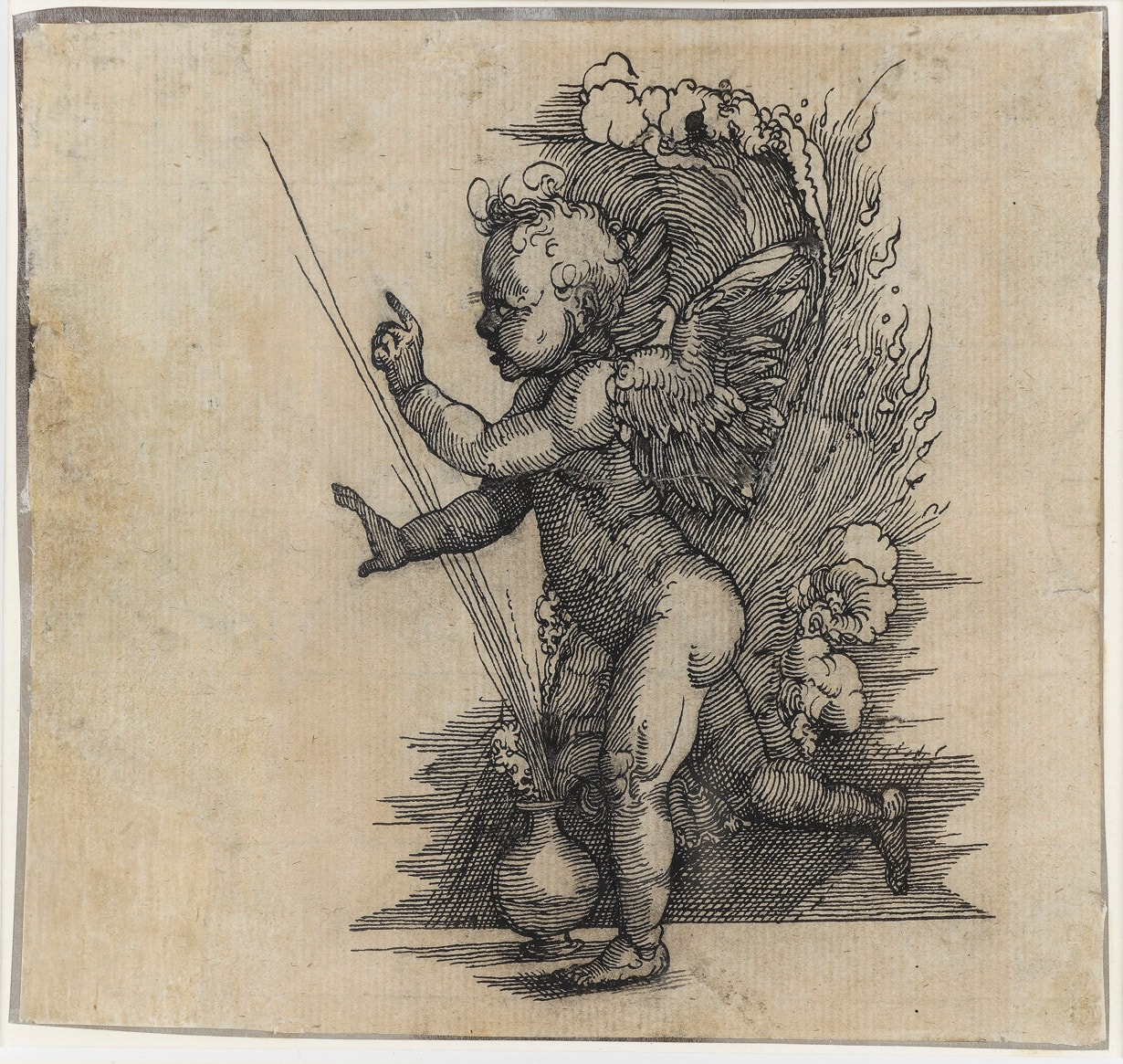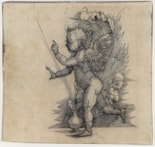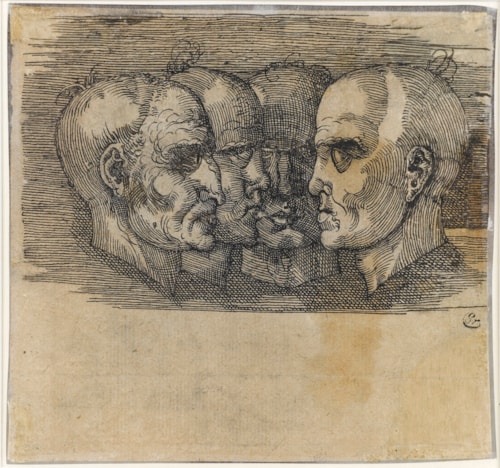Sebald BEHAM
(Nuremberg 1500 - Frankfurt-am-Main 1550)
A Putto Beside a Flaming Urn [recto]; Four Studies of Men’s Heads [verso]
Sold
Pen and black ink, over traces of an underdrawing in black chalk.
149 x 158 mm. (5 7/8 x 6 1/4 in.)
149 x 158 mm. (5 7/8 x 6 1/4 in.)
Drawings by Sebald Beham are relatively uncommon. Only a few may be related to his prints, and the present sheet is one of these. Both sides of this fine drawing are preparatory studies for two woodcuts used as illustrations for Das Kunst und Lehrbüchlin Sebalden Behams, a treatise on design and draughtsmanship written and illustrated by Beham. First published by Christian Egenolph in Frankfurt in 1546, the book was illustrated with twenty-six woodcuts by Beham; it proved very popular, and was reprinted several times until an eighth edition in 1605. The related woodcut of the putto with a flaming urn in the Kunst und Lehrbüchlin is signed with Sebald Beham’s monogram and dated 15463. A stylistically comparable drawing by the artist of a putto holding a sickle and a bunch of grapes, dated 1542, was formerly in the Edmund Schilling collection and is today in the British Museum. The woodcut of the four male heads is signed with the artist’s monogram, but undated. It is also inscribed Hie sihest du die vier angesichter ausgemacht und abgesetzt mitt / scharpfierung und schatten ausserhalb der linien reiß sie nach (‘Here you see the four faces which are offset with shading and shadows trace them outside of the lines’) in letterpress above the image. In the Kunst und Lehrbüchlin the woodcut follows another, related print of the same subject of four heads drawn within a single grid, but without hatching. Thirteen of the twenty woodcuts in the 1546 drawing manual are also studies of heads, and indeed Beham’s interest in expressive heads can also be seen in his earliest known drawing, a sheet of studies of eight heads, dated 1518, in the collection of the Herzog Anton Ulrich-Museum in Braunschweig.
Although the drawings on each side of the present sheet are in the same direction as the woodcuts and slightly larger in scale, the several slight differences between them, as well as the evident pentimenti (particularly visible in the right hand of the putto), point to the fact that this double-sided drawing is an autograph study for the two Kunst und Lehrbüchlin woodcuts. The attribution of the present sheet to Sebald Beham has been further confirmed by Dr. Matthias Mende and Dr. Kurt Löcher.
This drawing bears the collector’s mark of the 19th century German portrait painter August Grahl (1791-1868), who worked in Vienna, Berlin and Dresden, as well as in England. Grahl began collecting drawings on visits to Italy in 1821 and 1823.
Although the drawings on each side of the present sheet are in the same direction as the woodcuts and slightly larger in scale, the several slight differences between them, as well as the evident pentimenti (particularly visible in the right hand of the putto), point to the fact that this double-sided drawing is an autograph study for the two Kunst und Lehrbüchlin woodcuts. The attribution of the present sheet to Sebald Beham has been further confirmed by Dr. Matthias Mende and Dr. Kurt Löcher.
This drawing bears the collector’s mark of the 19th century German portrait painter August Grahl (1791-1868), who worked in Vienna, Berlin and Dresden, as well as in England. Grahl began collecting drawings on visits to Italy in 1821 and 1823.
Sebald Beham and his younger brother Barthel, together with Heinrich Aldegrever, Georg Pencz and other German printmakers active in the first half of the 16th century, were known as the ‘Little Masters’, due to the small size of much of their work. Both Beham brothers are thought to have studied with Albrecht Dürer in Nuremberg, and Sebald produced his first prints in 1518; engravings which were strongly indebted to the example of Dürer. Barthel Beham’s first prints date to around 1520, by which time Sebald had also taken up etching, again probably inspired by Dürer. Sebald also worked as a designer of stained glass panels, with considerable success. In 1525, however, both Beham brothers were expelled from Nuremberg on the grounds of sedition, and Sebald spent much of the next ten years working in Augsburg, Ingolstadt, Munich (where a woodcut was commissioned from him by the Emperor Charles V) and Mainz, where he entered the service of the archbishop, Cardinal Albrecht of Brandenburg, for whom he painted The Story of King David, now in the Louvre.
Sebald Beham eventually settled in Frankfurt around 1530, taking up citizenship there in 1540. He developed a close collaboration with Christian Egenolph, founder of the first printing press in Nuremberg, for whom he illustrated several religious books. Beham produced a large number of prints of ornamental and decorative designs, many of which were reproduced by goldsmiths, while other prints by him were copied by later artists. He is also known to have received commissions for manuscript illuminations, including two prayer books for Cardinal Albrecht, completed in 1531. In his lifetime, Beham produced some 270 engravings and etchings, and designed over a thousand woodcuts.
Provenance
Possibly Edward Montagu, 2nd Earl of Manchester (according to an inscription on the former mount)
August Grahl, Dresden (Lugt 1199), his stamp on the verso
Sabrina Förster, Düsseldorf, in 2005
Private collection, Europe
Anonymous sale, London, Sotheby’s, 4 July 2007, lot 3.
August Grahl, Dresden (Lugt 1199), his stamp on the verso
Sabrina Förster, Düsseldorf, in 2005
Private collection, Europe
Anonymous sale, London, Sotheby’s, 4 July 2007, lot 3.
Literature
Emmanuelle Brugerolles, Dürer et son temps. De la réforme à la guerre de trente ans: Dessins allemands de l’École des Beaux-Arts, Paris, 2012, p.119, under no.15, note 20.





